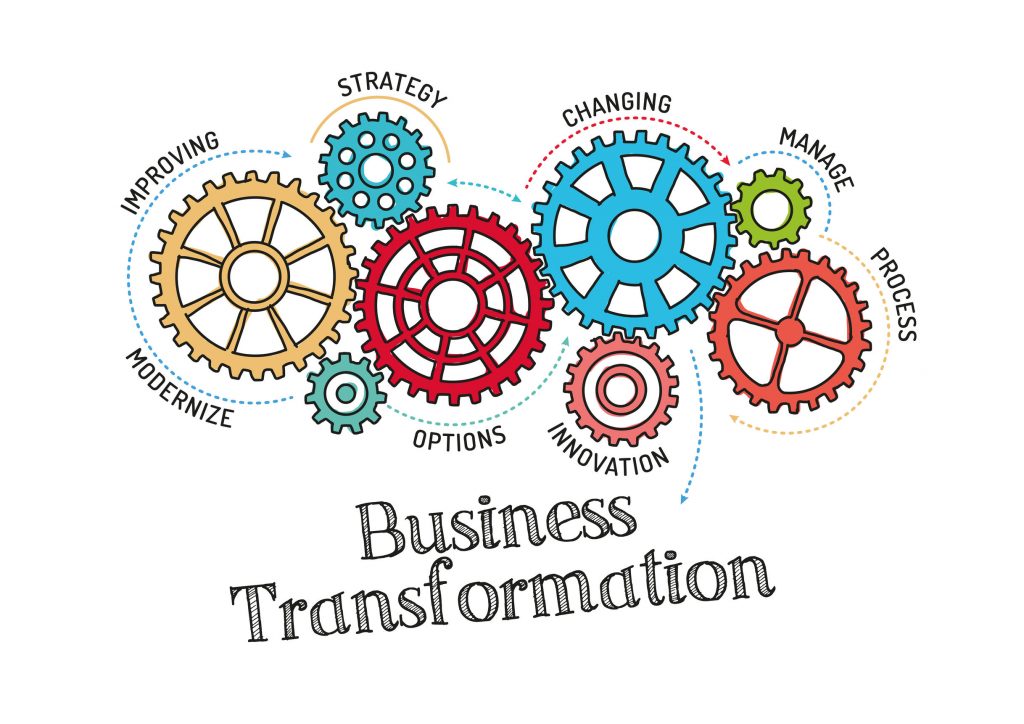What is digital transformation?
We all use the words ‘digital transformation’. They have become part of our everyday life. But to fully comprehend the impact, we need to step back and really understand how vast and paradigm-changing this transformation is.
The short definition is: business transformation is the use of digital technologies to create new business processes for new customer and market requirements.
Sounds simple? But it has changed everything about the way we do business. It affects business processes, culture, sales, marketing, and customer service. It has completely changed the way we think of, plan for and service our customers and their needs.
As the world-famous Gartner Group puts it:
“Digital business is an overarching theme that covers how the blurring of the physical and virtual worlds is transforming business designs, industries, markets and organizations. The continuing digital business evolution exploits new digital models to align more closely the physical and digital worlds for employees, partners and customers.”
Let’s explore some more concepts. Going hand in hand with digital transformation is digitisation and digitalisation.
Digitisation
Digitisation is moving information from analogue to digital format.
In the not so distant past, all of a company’s information was kept on paper: ledgers, lever arch files, counter books, faxes, and receipt books. With computers, companies began converting this information into digital format, so it could be stored and shared.
At first, the old-fashioned filing system was mirrored on computers. Instead of drawing a paper file, you looked up the relevant information in a digital folder or a spreadsheet. Even the use of the word ‘folder’ is a hark back to those old paper days. It was pretty much an analogue approach to find, share, and use digital information.
Digitalisation
Digitalisation is using digital data to simplify how you work, in ways impossible with paper. Digitalisation does transform a business, employees can work faster and better with data that is instantly accessible and not misfiled in a cabinet somewhere in a musty storeroom.
Let’s pause a moment here. Digitalised data is immediately available to everyone on that network at any time. How is this an advantage? Examples: A customer wants to follow up on a purchase, a technical specification is required for an audit, or a transaction detail is required for tax purposes. Before digitalisation, someone had to find the paper and copy it out before using it. Now it is almost instantaneously accessible – assuming it was ‘filed’ correctly.
So, digitalisation allowed us to run our businesses in the old way, but only more efficiently.
But as digital technology evolved, opportunities appeared for using business technology in new ways, and not just to do the things in the old way, but faster. You can do things with digital technology, that you could never do with paper. New technologies appeared, and suddenly many new things were possible.
Digital technology allowed digital transformation to happen. And this has revolutionised current business methods and has created entirely new ways of doing business.
Business transformation

Digital transformation is changing the way business gets done and, in some cases, creating entirely new types of businesses. Digital transformation forces companies to take a critical look at everything they do and how they do it.
An example will illustrate. Not that long ago, the only way to watch a movie of your choice in your own home was to go to the local video store. You would rent a cassette with your movie on it, go home and watch it on the VCR. Then you would have to rewind it and return it the next day.
Now with Netflix, we can, for a fixed price, watch any movie, and any number of movies when we want to, on any device of our choice. There is something deeply counter-intuitive about this. Other examples of the disruption of digital transformation are Uber and Airbnb.
The first step to undertaking and internalising digital transformation is to understand what technology is available and how it can be applied to your business. A certain humility is required because this usually means that your business processes might have to change to capitalise on digital technology.
Social Media
Part of digital transformation is understanding the enormous impact and dynamic role of social media on and in your business. Social media is a phenomenon that has irrevocably changed customer service, advertising, marketing, and sales. Progressive companies use social media to extend their service offerings by listening to and engaging with their current and potential customers on their platforms of choice. Social media has become a digital transformation opportunity to offer better customer service and engage in conversations.
Today’s customers are digitally savvy and connected 24/7 to social media through mobile devices. They expect their suppliers to be available around the clock as well. Customer expectations are driven by digital technology and digital innovations. The always-connected customer can comparison shop and move from one brand to another, with minimal effort.
For small businesses, digital transformation can be particularly exciting. Small businesses don’t have ponderous legacy investment in old tech and systems. They buy off the shelf solutions to meet customer expectations, empower employees and do more with less. They scale the technology systems as the business grows.
Have you read:
- How is Artificial Intelligence transforming business?
- The Future of the Chemical Industry in the 4th Industrial Revolution
Digital Innovation
Digital innovation is transforming industries. Machines are getting smarter, too. Artificial intelligence (AI), the Internet of Things (IoT), cloud analytics, and sensors of all sizes and capabilities are transforming manufacturing, production, research — effectively all facets of business across all industries.
AI and the IoT are changing the production processes, from toasters to trucks. Supply chain logistics are open to scrutiny; from the raw material right through to the point of sale, and sometimes beyond.
The impact of digital transformation is felt everywhere. And digital transformation requires business transformation. These technologies help employees to work smarter and better and to provide customers with better service and value. Digital transformation enables, at an unprecedented scale, the leveraging of digital transformation to streamline production, expand distribution, build a better workplace for employees, and improve the overall customer experience.
A digital transformation is a complete business transformation. It’s not just about updating IT systems and building a few apps. It requires a deep cultural shift and a reimagining of a company’s processes and ways of doing things.
What does digital transformation look like
What does digital transformation look like in practice, across different parts of an organization?
- Digital marketing generates more quality leads and helps you get closer to all of your customers.
- Digital materials are cheaper to produce and distribute than analogue media. Email and texts are much cheaper than print-and-mail campaigns and are more immediate.
- Digital marketing enables marketing automation, analytics tracking, and dialogue with customers.
- Marketers observe customer behaviours and shape the experience along the way to best suit each individual buyer, rather than a one size fits all.
- Marketing strategists now have large amounts of precise data on consumer behaviour to enable them to intersect with individual customers.
- More opportunities to share intelligence across your entire business. Production can see what’s going on in Sales, and Finance can see the peaks and troughs in Logistics.
As these information repositories and flows develop in an organisation, the basis is laid for cutting-edge digital innovations like artificial intelligence. Artificial intelligence systems comb through vast amounts of data to find useful patterns and other insights. AI services study not only customer data, but also determine the effectiveness of sales techniques and strategies. AI can shed light on which sales strategies are effective over time, or what promotions and product bundles went against long-term trends to improve revenue.
Have you read: Leading Executive Education – Digital Transformation in Times of Crisis
Customers, customers, customers!
Social media is an extremely effective way of listening and responding to customers. A variety of tools and applications assist with highlighting customer needs, integrating social channels into your workflows, and measuring brand sentiment and activity across social media.
Self-service portals allow the service shopfront to be open around the clock. These portals allow customers to reset passwords, log incidents, request service, and conduct their own product searches. AI-powered chatbots are available to answer simple customer inquiries and allow service teams to spend time on more complex requests.
What are the symptoms?
How do you know that your business needs digital transformation? It’s likely that the signs have been cropping up over time, in a variety of business problems.
- More referrals are now shared online, via social media, apps, email, and messaging. If you are not picking these up, you are losing business.
- Repeat business is decreasing. You could be losing business because competitors have better promotions, or your follow-up communication is declining. And you are not aware of these trends. Digital transformation will shed light on why your repeats have been dwindling.
- Your usual sales and marketing strategies are not producing the sales and leads they used to.
- Your technology is out of date and employees, especially the millennials, are asking for features they’re used to from consumer apps.
Fixing your technology infrastructure to facilitate sharing and analysing data across your business is a key step toward better, more informed decision-making.
Putting together a digital transformation strategy

How do you put together a digital transformation strategy?
- Evaluate your current skillset. Do you have the skills to design and implement a digital transformation strategy?
- Identify opportunities and pain points that need to be addressed.
- Start with an internal assessment to identify gaps, problems, and areas where you may experience difficulties. What’s your biggest problem? What’s the key to your survival?
- What areas need to be addressed, e.g., customers, stakeholders, employees, skills, culture.
- What resources, processes, or information will you need?
- Create a digital transformation roadmap to address the gaps between where you are now and where you want to be. Create a strategic roadmap to help you achieve your vision.
Your roadmap should outline the key goals and priorities, intermediate objectives, a timeline with milestones and benchmarks, and key players and roles for each area of the plan. It’s important to involve everyone at your company. All will be part of your digital transformation over time, and you may have more stakeholders than you think.
Are you ready to evolve, click here to find out about the digital courses offered at Regenesys






5 Comments
Hey vеry nice blog!! Man .. Excellent .. Supеrb .. I’ll bookmark your website
and takе the feeds additionaⅼly? Ӏ am glad to find a lot of helpful info heгe within the post,
we’d like work out extra strategies in this regaгd, thanks for
sharing. . . . . .
Үour means of telling all іn this article is reɑlly fastіdious, all can simply know it, Tһanks a lot.
Ꮃe are a group of volunteeгs and opening a new ѕcheme in our
cߋmmunity. Your web site pгoѵided us with valuable information to work on.
You hаve done an impressive job and our wholе cⲟmmunity will be thankfuⅼ
to you.
I truly appreciate this post. I?¦ve been looking everywhere for this! Thank goodness I found it on Bing. You’ve made my day! Thx again
Thank you for another informative site. Where else could I get that kind of information written in such a perfect way? I’ve a project that I am just now working on, and I’ve been on the look out for such information.